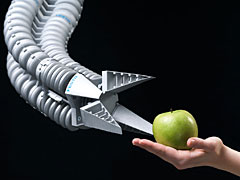Festo, a German-based company, has developed a robotic elephant trunk. Researchers at Festo were motivated by the structure and function of the elephant’s trunk and decided to revolutionize human-machine interaction, which is one of the biggest areas in robotics research.
 Robotic Elephant Trunk
Robotic Elephant Trunk
The company had worked along with the Institute for Manufacturing Engineering and Automation for developing a light-weight and soft components of the trunk, using three dimensional printing technology. These segments of the trunk are steered by powerful synthetic muscles that are powered by compressed air. These muscles are concealed deep inside the trunk.
The robotic limb is developed based on the Bionic Handling Assistant. It also features resistance sensors for curbing the extension of the limb when it identifies touch, thereby making the robotic trunk safe for interaction with humans.
Festo has included an innovative gripper featuring three fingers resembling the shape of fins. The fingers have detachable compartments. As the extreme ends of the unit get enfolded around the object, they disintegrate and confine the object. Since minimum force is required to grab the object, the possibility of injury is highly reduced.
Presently, the company is working on releasing robotic limbs of three different sizes for grasping several types of objects. The FinGripper is already utilized by their test clients in their manufacture lines.
The earlier robotic products of Festo include robotic penguins, manta rays and jellyfish.